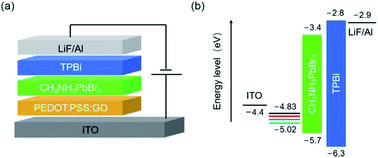Effects of PEDOT:PSS:GO composite hole transport layer on the luminescence of perovskite light-emitting diodes
Abstract
Perovskite light-emitting diodes (PeLEDs) employing CH3NH3PbBr3 as the emission layer (EML) and graphene oxide (GO) doped PEDOT:PSS as the hole transport layer (HTL) were prepared and characterized. GO doped in PEDOT:PSS can lead to the increased work function of HTL and lower the hole injection barrier at the HTL/CH3NH3PbBr3 interface, which facilitates the hole injection. Meanwhile, the optimized GO amount in PEDOT:PSS can help to reduce the quenching of luminescence occurring at the interface between HTL and perovskite. The luminance and current efficiency reach the maximum values of 3302 cd m−2 and 1.92 cd A−1 in PeLED with an optimized GO ratio (0.3), which increase by 43.3% and 73.0% in comparison with the undoped device, respectively. The enhanced luminescence of PeLEDs was caused by the combined effects of enhanced hole injection efficiency and the suppressed exciton quenching occurring at the HTL/EML interface. These results indicate that the introduction of traditional two-dimensional materials is a reasonable method for designing the structure of PeLEDs.

- This article is part of the themed collection: Graphene


 Please wait while we load your content...
Please wait while we load your content...